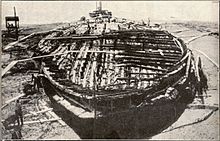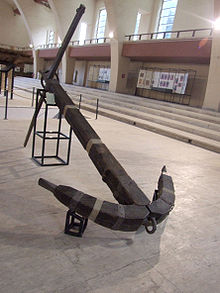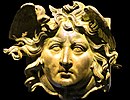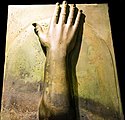Nemi ships
The Nemi ships were two large ancient ships that Emperor Caligula had built in honor of the goddess Diana during his time in office (37–41 AD) . They were recovered in 1929 and 1932 from Lake Nemi , the crater lake of an extinct volcano, 27 km southeast of Rome. In 1944 they were destroyed by fire.
The Diana cult
Caligula was closely associated with the goddess Diana. He had the sanctuary of Diana Nemorensis restored on the banks of Lake Nemi . Already in the Bronze Age there was a place of sacrifice at Nemisee, which in Roman times served to worship the goddess Diana. A direct continuity of a Bronze Age deity is obvious, but cannot be proven. After Nemi in 338 BC After it had been conquered by the Romans in the 3rd century BC, the sanctuary was enlarged monumentally and moved closer to the lake. It was an important pilgrimage destination, especially for women who wanted to have children.
The ships
The ships had gigantic dimensions in relation to the small lake with its approx. 1,000 m diameter: the first ship was 73 m long and 24 m wide, the second was 71 m by 20 m. Both had flat, keelless hulls. The bow and stern of the second ship were of the same construction so that it could go in both directions without turning.
A temple to Diana stood on one of the ships, adorned with marble columns, mosaic floors, and gilded bronze tiles. The second ship carried a palace complex for Caligula with a hot water system that supplied thermal baths on board. The ships could be assigned unequivocally through the lead pipes bearing the stamp of Caligula.
The hulls of the ships were protected by a coat of iron mint. Over it was a thin layer of wool impregnated with a mixture of pitch , bitumen, and resin . 1 mm thin lead plates were attached to this with copper nails. The ships were thus optimally protected against the accumulation of organisms such as mussels that would have damaged the wood. However, this problem only occurs in salt water and is not to be expected in the fresh water of Lake Nemi. This suggests that the ships were also prototypes on which ancient naval engineers tried out new techniques on the calm Lake Nemi for use at sea.
The ships had numerous technical details, such as anchors with movable flukes , taps , ball bearings and pump systems , which were only reinvented at the end of the 19th century. Some of these exhibits can still be seen in the museum today, some as replicated models.
It is unclear whether the ships were sunk immediately after the fall of Caligula 41 or only sank later. There are no ancient sources on the ships.
The rediscovery and recovery
In the Middle Ages the ships were forgotten, but ancient finds were repeatedly pulled from the lake by fishermen, who aroused curiosity about a treasure that was suspected in the lake. In 1446 Leon Battista Alberti tried to lift the ships. He had a raft built from barrels and from there he let ropes with hooks into the water. The attempt failed and only parts of a large statue were recovered. In 1531 Francesco De Marchi tried his luck with one of the first diving bells in history, but even he was only able to bring a few individual parts to light. Rescue attempts in 1827 and 1895 were just as unsuccessful. Parts of the ships were also damaged in these attempts. As a result of the unsuccessful rescue attempts, it was now clear that two large ships were hidden in the silt: one relatively close to the shore at a depth of 5 to 12 m, the second 200 m further to the center of the lake at a depth of 15 to 20 m.
The preliminary investigations for the most complex and ultimately successful campaign did not begin until 1924. In a speech on April 9, 1927, Benito Mussolini declared salvaging the ships to be an important goal of his government. In two years of work, the ancient tunnel was restored, through which the water of the lake could be pumped into a canal in the valley of Ariccia from October 1928 onwards so that the archaeologists could work on the ships on dry lake bed. At the same time, a road was built down from Genzano to the lake in order to better reach the archaeological site. The ancient Via Virbia , which opened up the sanctuary of Diana , was also found. A section of the ancient paving is now exposed in the museum.
On March 28, 1929, the first ship emerged from the water and the scientists began to document and examine the findings. A delegation from the English Royal Navy was also involved. The first ship was salvaged in September 1929. The second ship emerged from the lake in late January 1930 and was recovered in late 1932. The restored ships were finally presented to visitors in 1940 in the newly built museum on the lake shore.
The destruction
On the night of May 31st to June 1st, 1944, the museum and the ships were completely destroyed by fire. Only a few individual parts that had been relocated to the Museo Nazionale Romano in Rome were saved . An investigation immediately after the end of the war accused soldiers of the German Wehrmacht of intentional arson. Later, however, the possibility was also discussed that refugees who were staying in the museum at the time could have started the fire by an open fire, or that the fire was caused by shelling by American forces. The actual course of events can no longer be clarified.
The museum today
The Museo delle Navi Romane was built by Vittorio Ballio Morpurgo from 1933 to 1939. After a restoration, the museum was reopened in 1953, but closed again after a short time. After extensive restructuring, the museum was finally opened on December 15, 1988 and redesigned again in 2000. The two ships are shown today in models on a scale of 1: 5, as well as numerous individual pieces, some of them copies, that were saved in 1944. In addition, other archaeological finds from the area around Lake Nemi are shown in the museum. Some original pieces from the Nemi ships can also be seen in the Museo Nazionale Romano , in the Palazzo Massimo location.
The Associazione Dianae Lacus , founded in 1995, aims to reconstruct at least one of the ships in original size.
Original pieces from the Nemi ships
Original individual pieces from the Nemi ships that were recovered from Lake Nemi between 1895 and 1932.
- Details
Apotropaic ornament ( Gorgoneion ) in the form of a Medusa head attached to the head of a wooden beam at the front
The lion protomes with a round cross-section were located as an attached end piece on one of the two rudder axes
The wolf protomes with a square cross-section were located at the end and at the beginning of two wooden beams in the longitudinal axis for a platform on the longitudinal side of the ship, which primarily served as a landing stage. The rings of the wolf protomes were probably used to fasten dinghies
The panther protomes with a square cross-section were located at the end of two wooden beams in the transverse axis as extensions for a platform on each side of the ship, which primarily served as a landing stage. The rings of the panther protomes were probably used to fasten the ship to the landing stage
See also
literature
- Deborah N. Carlson: Caligula's Floating Palaces. In: Archeology, Volume 55, No. 3 (May / June 2002)
- Guido Uccelli: Le navi di Nemi . Libreria dello Stato, Rome 1940.
Web links
- Museo delle Nave Romane (Italian)
- Deutschlandfunk on the latest research
- Documentation from the municipality of Nemi
- Broadcast on Phoenix
- City demands money for ancient ships
Individual evidence
- ^ A b Marina Medici, Massimo Medici: Le navi di Nemi. In: comunedinemi.it. Retrieved May 23, 2020 (Italian).
- ↑ Sarah Wolfmayr: The Ships from Lago di Nemi, diploma thesis 2010 , at the Institute for Archeology, Graz 2009, (PDF online)
Coordinates: 41 ° 43 ′ 20 ″ N , 12 ° 42 ′ 7 ″ E










